Country guides

Things to do in Malaysia
Gleaming skyscrapers stand alongside colonial buildings in Malaysia, and verdant rainforests stretch all the way down to pristine beaches. Truly the myriad attractions offer something for everyone, whether visitors come to play or to unwind.
On the cultural side, tourists will encounter some of Asia's most well-known peoples and a few of its rarer groups, and every one of them has imprinted on the country, adding new notes to its character. Jungle walks, ancient caves, stunning mosques, isolated villages and the world's most diverse marine ecosystem are part of the experience as well, revealing how Malaysia celebrates Asia's history, and showcases many of its best features.
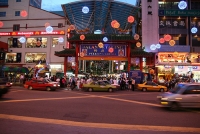
Chinatown
Chinatown is an intoxicating jumble of crowds, colours and authentic food. The central section of Petaling Street is closed at night, when the area is transformed into an exciting,…
Chinatown
Chinatown is an intoxicating jumble of crowds, colours and authentic food. The central section of Petaling Street is closed at night, when the area is transformed into an exciting, brightly lit shopping experience. Vendors spread their wares onto the pavement, displaying anything from toys to t-shirts and jewellery.
Shoppers will need to be careful, though, as many items are fake. Also, bargaining for the best price is expected and part of the fun. Many stalls operate during the day, but Chinatown is more special at night. Shoppers should be mindful of pick-pockets, regardless of what time of day they visit; culture lovers should note that the area has some tremendous Chinese temples.
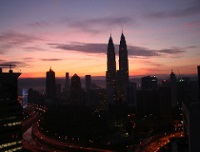
Petronas Towers
The Petronas Towers were designed to capture Malaysia's emergence as Southeast Asia's cultural and commercial centre. Celebrated as the world's tallest twin towers, they dominate t…
Petronas Towers
The Petronas Towers were designed to capture Malaysia's emergence as Southeast Asia's cultural and commercial centre. Celebrated as the world's tallest twin towers, they dominate the city skyline. Architects followed the traditional geometric principles of Islamic architecture when designing the buildings, using modern technology to stunning effect. Joined by a skybridge on the 41st floor, the towers are used as office complexes that form part of the Kuala Lumpur City Centre Development Park. They're particularly beautiful when lit up at night. Tours include crossing the famous bridge and going up to an observation deck on the 86nd floor, which offers phenomenal, 360-degree views of the city. Visitors can also enjoy an exhibition detailing the development of the towers, and purchase souvenirs at a gift shop.
Website www.petronastwintowers.com.my
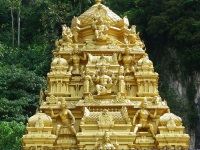
Batu Caves
Stalagmites and stalactites festoon the interior of these impressive limestone caves, together with shrines to Hindu deities. American naturalist, William Hornaday, is credited wit…
Batu Caves
Stalagmites and stalactites festoon the interior of these impressive limestone caves, together with shrines to Hindu deities. American naturalist, William Hornaday, is credited with discovering them in 1878, though they were already known Chinese settlers and local indigenous peoples. The caves have since become a Hindu holy site. They're especially relevant to the celebration of a three-day religious festival called Thaipusam. Thousands of devotees visit during the festival, paying penance and performing rites of self-flagellation. Visitors can reach the largest cave, Temple Cave, by climbing 272 steps. The path will lead them to Museum Cave, which houses a dazzling display of ornamental religious art. Travellers will enjoy the clear view from the top to the Sri Subramaniam Temple. Onsite companies offer rock climbing opportunities as well. Travellers who're interested should pack water, as the routes are challenging. Visitors should also watch out for monkeys, as they tend to steal things.
Website www.malaysiasite.nl/batucaveseng.htm
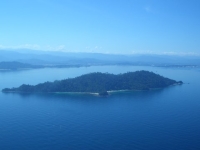
Tunku Abdul Rahman National Park
Five pristine islands make up Tunku Abdul Rahman National Park, with each idyllic setting comprising white beaches, offshore coral reefs and inland forests teeming with animal life…
Tunku Abdul Rahman National Park
Five pristine islands make up Tunku Abdul Rahman National Park, with each idyllic setting comprising white beaches, offshore coral reefs and inland forests teeming with animal life. These destinations are all perfect for camping, trekking, swimming and snorkelling. Gaya Island is the largest of the five and its status as a forest reserve since 1923 has helped preserve its dense tropical forest. Manukan Island is the second largest and the most popular with Malaysian locals. Mamutik Island is the smallest, though it makes up for that through sheer beauty. Sapi Island is very popular with foreign tourists, while Sulug Island is the most pristine and untouched of the chain.
Website www.sabahparks.org.my
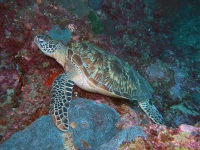
Sipadan Island
This mushroom-shaped island is known among divers around the world for its unique seascape and exceptional beauty. Around 3,000 varieties of fish, hundreds of coral species, and nu…
Sipadan Island
This mushroom-shaped island is known among divers around the world for its unique seascape and exceptional beauty. Around 3,000 varieties of fish, hundreds of coral species, and numerous rays, sharks and turtles populate its translucent waters. Sipadan Island certainly tops the Malaysian itinerary for serious scuba divers, given that it's located in the world's most bio-diverse marine habitat. The famous underwater explorer Jacques Cousteau once described it as 'an untouched piece of art'. Indeed, the Malaysian government has undertaken to preserve the fragile ecosystem by ordering dive resorts off the island, limiting the daily number of divers allowed in the water, and banning night dives.
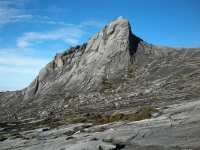
Mount Kinabalu
Mount Kinabalu rises from the Kinabalu National Park and, at an impressive 13,500-foot (4,101m), is one of the highest peaks in Southeast Asia. It's a relatively easy climb, though…
Mount Kinabalu
Mount Kinabalu rises from the Kinabalu National Park and, at an impressive 13,500-foot (4,101m), is one of the highest peaks in Southeast Asia. It's a relatively easy climb, though, with tourists of varying ages and fitness levels enjoying the two-to-three-day ascent. Most people spend a night at Laban Rata before mounting the summit. Along with being the name of a rest house that caters for hikers, Laban Rata is the name most people use for the area. The summit is a three-to-four-hour hike away from the hostel. Hikers should leave between 2am and 3am if they want to catch one of the area's magical sunrises.
Website www.sabahparks.org.my/
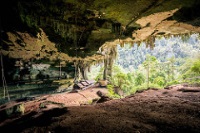
Niah National Park and Niah Caves
The Great Cave of Niah is one of the largest limestone caves in the world, and is where archaeologists discovered evidence of man's existence dating back 40,000 years. A display of…
Niah National Park and Niah Caves
The Great Cave of Niah is one of the largest limestone caves in the world, and is where archaeologists discovered evidence of man's existence dating back 40,000 years. A display of tools, rock paintings and human skulls tell the story of ancient civilisations. Limestone and lush tropical vegetation dominate the rest of the park, which nestles beneath the magnificent Mount Subis. Visitors reach the caves via a motorboat trip across a small crocodile-infested river and a one-hour-long trek through jungle. The walk is rewarding and may include some wildlife viewing. As for the cave, travellers should expect slippery conditions, and should pack a flashlight. The area's ancient rock paintings are a must-see.
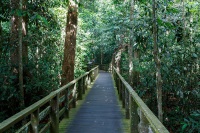
Sepilok Forest Reserve and Orangutan Sanctuary
Sabah District's vast, enchanting equatorial rainforest is home to the Sepilok Orangutan Sanctuary, where orphaned orangutans find temporary shelter and rehabilitation before their…
Sepilok Forest Reserve and Orangutan Sanctuary
Sabah District's vast, enchanting equatorial rainforest is home to the Sepilok Orangutan Sanctuary, where orphaned orangutans find temporary shelter and rehabilitation before their re-release into the forest. The centre was set up in 1964 and gives tourists and researchers the priceless opportunity to observe and engage with the animals in their natural habitat. Visitors are restricted to the walkways but orangutans often come over to interact. Photography is permitted, though tourists will pay an extra charge for bringing in a camera. The Sandakan Rainforest Discovery Centre (RDC) is also within the Sepilok Forest Reserve. The remarkable place allows guests to explore the jungle canopy on a series of raised platforms and walkways.
Website www.sabahtourism.com
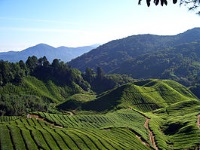
Cameron Highlands
Located at the northwestern edge of Pahang state, the Cameron Highlands hill station is the largest of its kind in Malaysia, and the fertile region is home to a scattering of villa…
Cameron Highlands
Located at the northwestern edge of Pahang state, the Cameron Highlands hill station is the largest of its kind in Malaysia, and the fertile region is home to a scattering of villages and terraced plantations. Visitors will enjoy the scenic drive along the area's main route, during which they can stop at the stunning Lata Iskandar Waterfalls and Kuala Woh Forest Recreation Park.
They can also stroll through Brinchang's market square, potter around handicraft stores, or sample the peace at Buddhist Temples. Ringlet and Tanah Rata are worth exploring for lovers of quaint towns; trips to tea plantations and strawberry farms are popular as well.
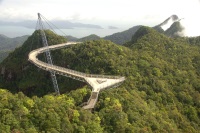
Langkawi
Langkawi is the collective name for a group of 99 tropical islands located 20 miles (30km) off the northwestern tip of the peninsula. Pulau Langkawi is the largest and most develop…
Langkawi
Langkawi is the collective name for a group of 99 tropical islands located 20 miles (30km) off the northwestern tip of the peninsula. Pulau Langkawi is the largest and most developed of them. Much of the island's prolific development has been focused in the town of Kuah, which is the embarkation point for visitors travelling by ferry.
Pulau's appeal flows from its hot springs, waterfalls, pristine beaches, limestone outcrops and stunning mountainous interiors. Visitors will also find plenty of shops and modern amenities. Langkawi is easily accessible by air or boat, though ferry crossings may cease during the monsoon season.
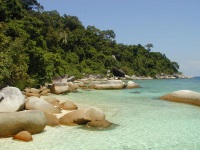
Perhentian Islands
Two islands make up the popular holiday destination, which is a backpacker's paradise. Fisherman double as tour guides, and simple beach bars spill out onto the pristine shore. Tra…
Perhentian Islands
Two islands make up the popular holiday destination, which is a backpacker's paradise. Fisherman double as tour guides, and simple beach bars spill out onto the pristine shore. Travellers have the option of securing more high-end accommodation if they want, though the islands are an iconic stop on the budget traveller's itinerary.
This largely undeveloped region is located within the Terengganu Marine Park, where divers and snorkelers can enjoy clean water and gorgeous coral reefs. Visitors can reach the islands via taxi boats from the town of Kuala Besut. They should also note that the east-coast monsoon often makes the islands inaccessible between November and January.


